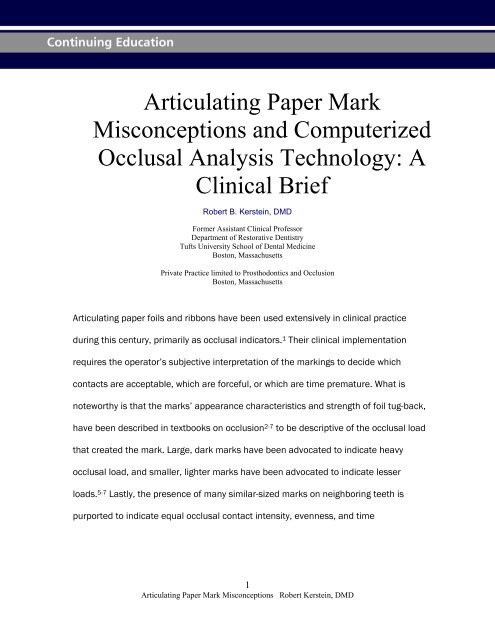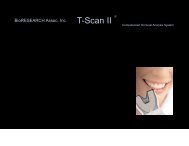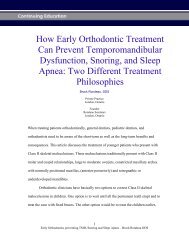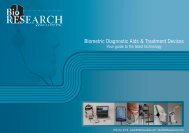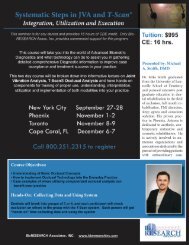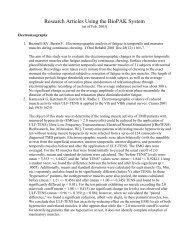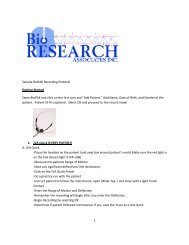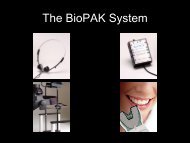Articulating Paper Mark Misconceptions and Computerized Occlusal ...
Articulating Paper Mark Misconceptions and Computerized Occlusal ...
Articulating Paper Mark Misconceptions and Computerized Occlusal ...
Create successful ePaper yourself
Turn your PDF publications into a flip-book with our unique Google optimized e-Paper software.
<strong>Articulating</strong> <strong>Paper</strong> <strong>Mark</strong><br />
<strong>Misconceptions</strong> <strong>and</strong> <strong>Computerized</strong><br />
<strong>Occlusal</strong> Analysis Technology: A<br />
Clinical Brief<br />
Robert B. Kerstein, DMD<br />
Former Assistant Clinical Professor<br />
Department of Restorative Dentistry<br />
Tufts University School of Dental Medicine<br />
Boston, Massachusetts<br />
Private Practice limited to Prosthodontics <strong>and</strong> Occlusion<br />
Boston, Massachusetts<br />
<strong>Articulating</strong> paper foils <strong>and</strong> ribbons have been used extensively in clinical practice<br />
during this century, primarily as occlusal indicators. 1 Their clinical implementation<br />
requires the operator’s subjective interpretation of the markings to decide which<br />
contacts are acceptable, which are forceful, or which are time premature. What is<br />
noteworthy is that the marks’ appearance characteristics <strong>and</strong> strength of foil tug-back,<br />
have been described in textbooks on occlusion 2-7 to be descriptive of the occlusal load<br />
that created the mark. Large, dark marks have been advocated to indicate heavy<br />
occlusal load, <strong>and</strong> smaller, lighter marks have been advocated to indicate lesser<br />
loads. 5-7 Lastly, the presence of many similar-sized marks on neighboring teeth is<br />
purported to indicate equal occlusal contact intensity, evenness, <strong>and</strong> time<br />
1<br />
<strong>Articulating</strong> <strong>Paper</strong> <strong>Mark</strong> <strong>Misconceptions</strong> Robert Kerstein, DMD
simultaneity. 2,3 These paper mark appearance perceptions have been trusted by<br />
practitioners for more than 100 years as a basis with which to select contacts<br />
requiring correction.<br />
Published studies about articulating paper are analyses of the physical properties of<br />
the papers themselves (thickness, composition, ink substrate, plastic deformation),<br />
<strong>and</strong> offer no scientific evidence to suggest that articulating paper can measure<br />
occlusal loads. 8,9 Additionally, Millstein reported that, in the literature, there are no<br />
proven, scientifically based, proper-use guidelines, for the clinician to follow when<br />
using articulating paper. 1<br />
Current research on articulating paper mark size has revealed that the size of an<br />
articulating paper mark does not describe occlusal forces. 10 An analysis of 600 paper<br />
markings, made at varying human occlusal loads on epoxy dental casts, determined<br />
that articulating paper mark size can vary so greatly at a given human occlusal load,<br />
that an operator would be unable to determine from visual inspection of the markings<br />
which marks were forceful <strong>and</strong> which were not. 10 A given mark of virtually any size or<br />
color intensity (large, small, scratch-like; light, dark) could hold a range of loads (from<br />
0 N to 500 N) despite its “size” appeareance. 10 The study also showed that similar,<br />
equally sized marks on neighboring teeth did not represent equal loads.10 The<br />
authors reported that only 21% of the marks correlated to the applied occlusal load,<br />
2<br />
<strong>Articulating</strong> <strong>Paper</strong> <strong>Mark</strong> <strong>Misconceptions</strong> Robert Kerstein, DMD
3<br />
<strong>Articulating</strong> <strong>Paper</strong> <strong>Mark</strong> <strong>Misconceptions</strong> Robert Kerstein, DMD
while 79% of the marks did not describe the applied load that<br />
imprinted the marks to the casts. 10<br />
What this means to the clinician is that choosing the marks to<br />
adjust based on their “size” is highly error-prone. Therefore, in<br />
a given pattern of marks spread over neighboring teeth, any<br />
size mark could indicate any load (Figure 1A <strong>and</strong> Figure 1B).<br />
Figure 1A<br />
<strong>Articulating</strong> paper<br />
markings of upper<br />
left PFM fixed<br />
bridge. Current<br />
research has shown<br />
that any size mark<br />
could contain any<br />
occlusal load despite<br />
size <strong>and</strong> appearance.<br />
Figure 1B Distribution of mark sizes at various loads for<br />
the m<strong>and</strong>ibular teeth. Note that at 400 pixels (a given<br />
mark size) there are seven different loads represented<br />
(outlined in blue), <strong>and</strong> at 200 N (a given load) there are<br />
16 different mark sizes represented (outlined in red)<br />
(reprinted with permission, Carey et al10).<br />
4<br />
<strong>Articulating</strong> <strong>Paper</strong> <strong>Mark</strong> <strong>Misconceptions</strong> Robert Kerstein, DMD
Figure 1B shows how variable the marks <strong>and</strong> the loads were for all of the m<strong>and</strong>ibular<br />
markings studied. Note that at 400 pixels (a single mark size) there are seven<br />
different loads represented, <strong>and</strong> at 200 N (a single load) there are 16 different mark<br />
sizes represented. This wide range of mark sizes per load demonstrates why mark<br />
size is a poor indicator of applied occlusal load.<br />
Despite the apparent clinical success with the use of paper mark size as an occlusal<br />
contact selection guide, it appears that using mark size as a force guide can result in<br />
poor force applications to the occlusion. The occlusal design likely would contain<br />
unseen force aberrations, regardless of how uniform or “even” the articulating paper<br />
markings appeared. These unseen aberrations could shorten the life of any<br />
restoration, <strong>and</strong> result in postinsertion patient discomfort when the occlusal design is<br />
not accepted by the prosthetic patient. In this era of immobile dental implants <strong>and</strong><br />
brittle all-ceramic restorative materials, more precise occlusal force control is required<br />
of all practitioners to ensure material longevity. In a study of 76 maxillary overdenture<br />
implant prostheses with metallic superstructures incorporated into their design, 70%<br />
of the prostheses (n = 54) exhibited damage that required repair after 3 years in<br />
service, despite the authors’ “belief” that they had balanced the occlusion on each<br />
prosthesis, using articulating paper only to guide the corrections. 11<br />
5<br />
<strong>Articulating</strong> <strong>Paper</strong> <strong>Mark</strong> <strong>Misconceptions</strong> Robert Kerstein, DMD
The findings of these 2 studies suggest that the modern clinician needs an occlusal<br />
contact measuring device that can isolate aberrant occlusal force concentrations <strong>and</strong><br />
time prematurities reliably. As an alternative method to the operator’s subjective<br />
interpretation of articulating mark appearance, computerized occlusal analysis is<br />
available to the practitioner (T-Scan® III, Tekscan Inc, South Boston, MA).<br />
<strong>Computerized</strong> occlusal analysis has evolved over the past 25 years to become a<br />
Windows®-based, high-technology occlusal clinical tool, with which to underst<strong>and</strong><br />
occlusal contact functional <strong>and</strong> parafunctional forces, contact timing sequences, <strong>and</strong><br />
occlusal surface interface pressures. The system can be used to diagnose occlusal<br />
Figure 2A T-Scan III system<br />
recording h<strong>and</strong>le <strong>and</strong> sensor.<br />
Figure 2B USB recording<br />
h<strong>and</strong>le connected to a computer<br />
workstation (laptop).<br />
6<br />
<strong>Articulating</strong> <strong>Paper</strong> <strong>Mark</strong> <strong>Misconceptions</strong> Robert Kerstein, DMD
problems, identify occlusal contact force <strong>and</strong> time aberrances, <strong>and</strong> guide the operator<br />
through occlusal adjustments during prosthetic <strong>and</strong> implant dentistry insertions. 12-15<br />
In 2006, a USB plug-in recording h<strong>and</strong>le <strong>and</strong> new generation of software were<br />
released as the T-Scan III occlusal analysis system for Windows (Figure 2A <strong>and</strong> Figure<br />
2B). The system displays a recorded occlusal “force movie,” 16 which illustrates the<br />
various occlusal pressures with colors during playback. The darker colors represent<br />
low occlusal pressures <strong>and</strong> the<br />
brighter colors indicate higher occlusal<br />
pressures.<br />
There are numerous researched <strong>and</strong><br />
published clinical applications of<br />
computerized occlusal analysis. 12-<br />
15,17,18 There are known uses in<br />
occlusal therapy, temporom<strong>and</strong>ibular<br />
disorder treatment, <strong>and</strong> fixed,<br />
removable, <strong>and</strong> implant<br />
prosthodontics. One of the most<br />
Figure 3A Image from computerized occlusal<br />
analysis software showing the occlusal forces<br />
graded in colors. The “force movie” shows that<br />
early contact in m<strong>and</strong>ibular closure is at 7.9% of<br />
total force. Teeth Nos. 10 <strong>and</strong> 11 are early <strong>and</strong><br />
forceful to their neighbors; they are taller<br />
columns in height, <strong>and</strong> are lighter in (green)<br />
color, whereas their neighbors are shorter in<br />
height <strong>and</strong> darker (blue) in color.<br />
7<br />
<strong>Articulating</strong> <strong>Paper</strong> <strong>Mark</strong> <strong>Misconceptions</strong> Robert Kerstein, DMD
important applications is the<br />
system’s ability to describe the<br />
occlusal contact timing order<br />
(which cannot be observed in<br />
articulating paper markings) as<br />
the different occlusal contacts<br />
sequentially load. Figure 3A<br />
through Figure 3C are successive<br />
“force movie” frames that<br />
illustrate the evolution of differing<br />
areas of excessive occlusal force<br />
in an intercuspated closure over a<br />
Figure 3B In the middle of m<strong>and</strong>ibular closure<br />
(0.09 seconds later), the “force movie” shows<br />
contact is at 39.7% of total force. Teeth Nos. 3<br />
<strong>and</strong> 9 are forceful relative to their neighbors; No.<br />
9 is the light green, tallest column anteriorly,<br />
<strong>and</strong> No. 3 is the light orange, tallest column<br />
posteriorly.<br />
0.16 second time period. The first overloaded teeth are Nos. 10 <strong>and</strong> 11 (Figure 3A);<br />
next, after 0.09 seconds has elapsed, teeth Nos. 3 <strong>and</strong> 9 become forceful (Figure 3B);<br />
<strong>and</strong> lastly, 0.07 seconds later, teeth Nos. 14 <strong>and</strong> 15 become forceful (Figure 3C).<br />
These six overloaded teeth were precisely isolated <strong>and</strong> visualized, making their<br />
correction simple for the operator to perform.<br />
8<br />
<strong>Articulating</strong> <strong>Paper</strong> <strong>Mark</strong> <strong>Misconceptions</strong> Robert Kerstein, DMD
Within the literature, there are<br />
published proper-use guidelines<br />
available to the clinician to predictably<br />
use the technology (unlike articulating<br />
paper). These guidelines have been<br />
determined from human subject<br />
occlusal research performed from the<br />
1980s to the present day. 19-24<br />
<strong>Paper</strong> <strong>Mark</strong> Misperception:<br />
A Clinical C<br />
Example<br />
Figure 3C Later in same m<strong>and</strong>ibular closure<br />
(0.07 seconds later), the “force movie”<br />
shows contact is at 73.6% of total force.<br />
Teeth Nos. 14 <strong>and</strong> 15 are forceful relative to<br />
all teeth; Nos. 14 <strong>and</strong> 15 have the tallest<br />
columns of any teeth in the arch, with dark<br />
orange <strong>and</strong> red denoting the highest occlusal<br />
forces.<br />
An example of a typical paper mark misperception can be<br />
seen in Figure 1. The previously installed upper left fixed<br />
porcelain-fused-to-metal (PFM) bridge had been<br />
uncomfortable for the patient to occlude upon since delivery.<br />
Over a 3- to 4-month period postinsertion, the patient<br />
underwent several “paper-only” corrective adjustment<br />
Figure 1<br />
9<br />
<strong>Articulating</strong> <strong>Paper</strong> <strong>Mark</strong> <strong>Misconceptions</strong> Robert Kerstein, DMD
appointments, hoping to alleviate the pain. The pain persisted, however, most likely<br />
because the problem contact(s) was not isolated predictably, leading the clinician to<br />
consider endodontics as a solution.<br />
The patient, instead, underwent a computerized occlusal analysis examination of the<br />
upper left bridge, which revealed that the damaging occlusal contact was present on<br />
the distopalatal aspect of tooth No. 15 (Figure 4). This contact was time premature<br />
Figure 4 <strong>Computerized</strong> occlusal analyses of PFM bridge seen in Figure 1. Note the<br />
extreme contact on the distopalatal aspect of tooth No. 15. This contact is the<br />
smallest paper mark in Figure 1. Also note the low force on tooth No. 11 <strong>and</strong> large<br />
corresponding paper mark.<br />
10<br />
<strong>Articulating</strong> <strong>Paper</strong> <strong>Mark</strong> <strong>Misconceptions</strong> Robert Kerstein, DMD
<strong>and</strong> overloaded at only 48% of the patient’s<br />
total occlusal force (Figure 4; tall red<br />
column). Note that in Figure 1 <strong>and</strong> Figure 5,<br />
this contact is the smallest mark on the<br />
bridge. Also, the computerized occlusal<br />
analysis measured tooth No. 11 as low force<br />
(Figure 4; short blue column), but this area<br />
has a very large, dark paper marking. This is<br />
another example of how the appearance of a<br />
paper mark can be misleading force-wise.<br />
After identification, the problem contact was<br />
adjusted <strong>and</strong> endodontic treatment was<br />
avoided. Had computerized occlusal analysis<br />
been used at the time of bridge delivery, the<br />
problem contact readily would have been<br />
isolated, <strong>and</strong> 4 months of patient discomfort<br />
would have been avoided.<br />
Figure 5 <strong>Articulating</strong> paper markings of<br />
upper left PFM fixed bridge with a circle<br />
outlining the “problem” occlusal contact<br />
that was isolated with computer analysis.<br />
This forceful contact was overlooked<br />
repeatedly at many postinsertion<br />
appointments during visual paper mark<br />
inspection of the occlusal contacts.<br />
11<br />
<strong>Articulating</strong> <strong>Paper</strong> <strong>Mark</strong> <strong>Misconceptions</strong> Robert Kerstein, DMD
12<br />
<strong>Articulating</strong> <strong>Paper</strong> <strong>Mark</strong> <strong>Misconceptions</strong> Robert Kerstein, DMD
Summary<br />
<strong>Articulating</strong> paper mark size now is understood to be nondescriptive of occlusal loads.<br />
Many different sized marks can represent the same load, <strong>and</strong> equal sized marks do<br />
not represent equal loads. Therefore, choosing paper marks to adjust occlusion,<br />
based on their relative size, is tantamount to “guessing.” It is important that practicing<br />
dentists worldwide realize that articulating paper mark size is subject to interpretation<br />
<strong>and</strong> a highly unreliable method to use in the assessment of applied occlusal loads.<br />
<strong>Computerized</strong> occlusal analysis completely removes the operator’s subjectivity from<br />
the clinical decision-making process when observing paper markings of various sizes<br />
<strong>and</strong> configurations. When using this technology, mark size, mark color depth, “donut”-<br />
shaped halo contacts, <strong>and</strong> other color <strong>and</strong> size mark appearance characteristics are<br />
ignored as “force indicators,” <strong>and</strong> used only as “contact locators.” The operator’s<br />
subjective paper mark misperceptions are replaced with accurate knowledge of the<br />
true <strong>and</strong> measured contact order, contact applied load, contact quality, <strong>and</strong> proper<br />
contact isolation where problematic.<br />
13<br />
<strong>Articulating</strong> <strong>Paper</strong> <strong>Mark</strong> <strong>Misconceptions</strong> Robert Kerstein, DMD
Disclosure<br />
The author is a clinical consultant for Tekscan Inc.<br />
References<br />
1. Millstein P. Know your indicator. J Mass Dental Soc. 2008;56(4):30-31.<br />
2. Glickman I. Clinical Periodontics. 5th ed. Philadelphia, PA: Saunders <strong>and</strong> Co;<br />
1979:951.<br />
3. McNeil C. Science <strong>and</strong> practice of occlusion. Carol Stream, IL: Quintessence<br />
Publishing; 1997:421.<br />
4. Harper KA, Setchell DA. The use of shimstock to assess occlusal contacts: a<br />
laboratory study. Int J Prosthodont. 2002;15(4):347-352.<br />
5. Okeson J. Management of Temporom<strong>and</strong>ibular Disorders <strong>and</strong> Occlusion. 5th ed.<br />
St. Louis, MO: CV Mosby <strong>and</strong> Co; 2003:416,418,605.<br />
6. Kleinberg I. Occlusion Practice <strong>and</strong> Assessment. Oxford, UK: Knight Publishing;<br />
1991:28.<br />
14<br />
<strong>Articulating</strong> <strong>Paper</strong> <strong>Mark</strong> <strong>Misconceptions</strong> Robert Kerstein, DMD
7. Smukler H. Equilibration in the natural <strong>and</strong> restored dentition. Chicago, IL:<br />
Quintessence Publishing; 1991:110.<br />
8. Schelb E, Kaiser DA, Brukl CE. Thickness <strong>and</strong> marking characteristics of occlusal<br />
registration strips. J Prosthet Dent. 1985;54(1):122-126.<br />
9. Halperin GC, Halperin AR, Norling BK. Thickness, strength, <strong>and</strong> plastic<br />
deformation of occlusal registration strips. J Prosthet Dent. 1982;48(5):575-578.<br />
10. Carey JP, Craig M, Kerstein RB, et al. Determining a relationship between<br />
applied occlusal load <strong>and</strong> articulating paper mark area. The Open Dentistry Journal.<br />
2007;(1):1-7.<br />
11. Kaptein MLA, DePutter C, DeLange GL, et al. A clinical evaluation of 76 implant<br />
supported superstructures in the composite grafted maxilla. J Oral Rehab.<br />
1999;26(8):619-623.<br />
12. Kerstein RB. <strong>Computerized</strong> occlusal management of a fixed/detachable implant<br />
prosthesis. Pract Periodontics Aesthet Dent. 1999;11(9):1093-1102.<br />
13. Kerstein RB. Montgomery M. Mapping occlusal forces on rebuilt anterior<br />
guidance. Contemporary Esthetics. 2000;14(4);68-73.<br />
15<br />
<strong>Articulating</strong> <strong>Paper</strong> <strong>Mark</strong> <strong>Misconceptions</strong> Robert Kerstein, DMD
14. Kerstein RB. Current applications of computerized occlusal analysis in dental<br />
medicine. Gen Dent. 2001;49(5):521-530.<br />
15. Kerstein RB, Grundset K. Obtaining measurable bilateral simultaneous occlusal<br />
contacts with computer-analyzed <strong>and</strong> guided occlusal adjustments. Quintessence Int.<br />
2001;32:7-18<br />
16. Maness WL. Force movie: a time <strong>and</strong> force view of occlusal contacts. Compend<br />
Contin Educ Dent. 1989;10(7);404-408.<br />
17. Kerstein R. Disclusion time reduction therapy with immediate complete anterior<br />
guidance development: the technique. Quintessence Int. 1992;23:735-747.<br />
18. Kerstein RB. Non-simultaneous tooth contact in combined implant <strong>and</strong> natural<br />
tooth occlusal schemes. Pract Proced Aesthet Dent. 2001;13(9);751-756.<br />
19. Kerstein RB, Wright NR. Electromyographic <strong>and</strong> computer analyses of patients<br />
suffering from chronic myofascial pain-dysfunction syndrome: before <strong>and</strong> after<br />
treatment with immediate complete anterior guidance development. J Prosthet<br />
Dent.1991;66(5):677-686.<br />
16<br />
<strong>Articulating</strong> <strong>Paper</strong> <strong>Mark</strong> <strong>Misconceptions</strong> Robert Kerstein, DMD
20. Kerstein RB, Chapman R, Klein M. A comparison of ICAGD (immediate complete<br />
anterior guidance development) to mock ICAGD for symptom reductions in chronic<br />
myofascial pain dysfunction patients. Cranio. 1997;15(1):21-37.<br />
21. Kerstein RB. Disclusion time measurement studies: a comparison of disclusion<br />
time between chronic myofascial pain dysfunction patients <strong>and</strong> nonpatients: a<br />
population analysis. J Prosthet Dent. 1994;72(5);473-480.<br />
22. Kerstein RB. Disclusion time measurement studies: stability of disclusion time—<br />
a 1-year follow-up study. J Prosthet Dent. 1994;72(2):164-168.<br />
23. Kerstein RB, Lowe M, Harty M, et al. A force reproduction analysis of two<br />
recording sensors of a computerized occlusal analysis system. Cranio. 2006;24(1);15-<br />
24.<br />
24. Kerstein RB, Radke J. The effect of disclusion time reduction on maximal clench<br />
muscle activity level. Cranio. 2006;24(3);156-165.<br />
17<br />
<strong>Articulating</strong> <strong>Paper</strong> <strong>Mark</strong> <strong>Misconceptions</strong> Robert Kerstein, DMD


